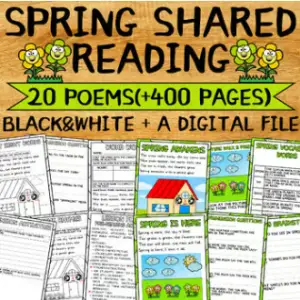Your cart is currently empty!
Spring Shared Reading Poems and Lesson Plans
Spring is a refreshing time of year to breathe new life into your literacy block. With the weather warming up and students energized by the change of season, it’s a great opportunity to make shared reading more engaging and effective. Whether you’re working with Kindergarteners or second graders, spring shared reading offers meaningful ways to develop fluency, sight word recognition, and comprehension skills.
This post shares practical tips for bringing seasonal poetry into your classroom through shared reading routines that are both fun and impactful.
1. Choose Seasonal Poems That Capture Attention
One of the best ways to engage students in spring shared reading is by selecting poems that reflect the season. Topics like rain showers, blooming flowers, insects, and outdoor adventures immediately spark interest and provide a context students can relate to.
Look for poems that:
Have a clear rhythm and rhyme
Contain spring vocabulary
Are short enough for repeated reading
Using seasonal content makes the reading experience feel relevant and timely, which helps students connect emotionally and cognitively with the text.
–Click here for a free sample.
–Click here for the full version.
2. Start with Pre-Reading Activities
Before diving into a poem, set the stage with activities that activate prior knowledge and curiosity. These include:
Brainstorming ideas related to the poem’s theme
Making predictions based on the poem’s title or visuals
Introducing key vocabulary words
Taking time to prepare students helps increase comprehension and encourages more meaningful participation during shared reading.
Click here to access all the essential resources you need this spring!
3. Focus on Choral Reading to Build Fluency
Shared reading is ideal for developing reading fluency through repeated practice. Choral reading, where students read together in unison, can build confidence and rhythm. Try different approaches:
Echo reading: Teacher reads a line, students repeat
Group reading: Everyone reads together
Partner reading: Pairs take turns reading aloud
These variations keep students engaged while reinforcing fluency and expression.
4. Reinforce Sight Words and Phonics Skills
Spring poems provide a perfect platform for reviewing high-frequency words and phonics patterns. After reading, highlight key sight words and discuss their meaning. You can also:
Identify rhyming words
Explore word families
Match seasonal vocabulary to definitions
These activities help strengthen decoding and word recognition in a meaningful context.
5. Use Comprehension Questions for Deeper Thinking
To encourage students to think critically, ask open-ended comprehension questions after reading. For example:
What was the main idea of the poem?
How did the poem make you feel?
What words or lines stood out to you?
Encouraging students to explain their thinking helps them move beyond surface-level understanding.
6. Extend Learning with Creative Follow-Ups
To deepen learning, extend your shared reading with creative, hands-on activities. You might have students:
Create their own spring poem inspired by the original
Act out the poem as a short performance
These extensions allow for differentiated instruction and keep the learning process engaging.
7. Offer Both Digital and Printable Options
Flexibility is important in modern classrooms. Using both digital and printable shared reading materials ensures you can adapt activities for in-person, online, or blended settings. Look for resources that include both formats so you can meet your students’ needs, no matter the learning environment.
Final Thoughts
Spring shared reading is an excellent opportunity to blend literacy instruction with seasonal themes that students enjoy. By incorporating choral reading, sight word practice, comprehension strategies, and creative extensions, you can create a literacy experience that builds skills and enthusiasm for reading.




Leave a Reply